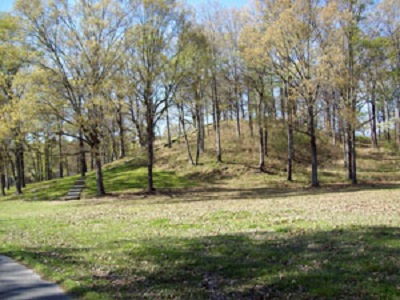
Courtesy of kniemla on Flickr
Poverty Point contains some of the largest prehistoric earthworks in North America that, like the pyramids of Egypt, were a massive building project involving the labor of many people. Located on more than 400 acres, the complex is a series of earthen mounds and ridges that overlook the Mississippi River flood plain in what is now northeastern Louisiana. A large, sophisticated society about which we know little constructed the impressive complex. Today, Poverty Point National Monument, operated by the State of Louisiana as a State park, records the technological and economic achievements of a bygone people.
Visitors have several options for exploring these mounds that people who lived in the area constructed from roughly 1650 to 700 BC. Poverty Point is a large mound complex—its builders manipulated approximately 1 million cubic yards of earth for the initial construction of the mounds. A guided tram tour through the site is offered at different times throughout the day. The tram tour provides the opportunity to visit one of the larger outer mounds of the complex, Mound A. Visitors may also explore the site on their own through self-guided tours. A museum offers an orientation and history of the site.
A hunter-gatherer society built Poverty Point, a massive network of artificially created ridges and mounds surrounding a plaza. Archeologists, including those at the on-site archeological laboratory at Poverty Point, continue to attempt to discover information about the society and the reason for the construction of the mound complex. Strategically located away from frequently flooded areas, Poverty Point is in the Lower Mississippi Valley. Here, the peoples of Poverty Point created not only the massive earthworks, but also an extensive trade network that stretched outwards for almost a thousand miles.
Relatively little is known about the Poverty Point society. Objects like clay cooking balls, spear points, and fishing tools found at the site give us some idea as to how the mound builders ate and lived. Because of the quality, diversity, and quantity of jewelry and other objects found at Poverty Point, some speculate that it may have been a capital for an entire ancient culture. The size of the complex and the number of objects are not what make Poverty Point remarkable, though. While research about the society that built Poverty Point continues, it is clear that those who moved the earth, basket by basket, were not sedentary peoples; it is unusual that a mobile society of hunter-gatherers could build the complex system of mounds at Poverty Point.
The hunter-gatherer group that constructed Poverty Point was always on the move, looking for plants and animals. Not cultivating crops for support in between hunts, hunter-gatherer groups had to move frequently to access new food sources; that a pre-agricultural society could perform such a building feat is remarkable. The construction of Poverty Point would have required work and residence in a fixed location. Given this, archeologists and anthropologists today continue to be puzzled over how such a loosely connected and constantly moving group of people could come together to fashion the complicated, planned mound complex at Poverty Point.
How long did they stay? How did they support themselves while building the mounds? Some of these questions have answers while others do not, as Poverty Point continues to be a mystery. Visitors can explore one of the most important mound complexes in North America, learn what is known, and ponder the mysteries and still unanswered questions about the site and the lives of the people responsible for Poverty Point.
Poverty Point National Monument (Monumental Earthworks of Poverty Point) is a World Heritage Site, National Monument, and National Historic Landmark located at 6859 Highway 577, Pioneer LA. Monumental Earthworks of Poverty Point is open daily from 9:00am to 5:00pm except for Thanksgiving, Christmas Day, and New Year's Day. For more information, visit the Louisiana State Parks Poverty Point World Heritage Site website or call 318-926-5492 or 1-888-926-5492, and also visit the National Park Service Poverty Point National Monument website.
In addition to guided tours, including a tram tour, the park offers visitors self-guided tours, a museum, and picnic areas. An online video, Poverty Point Earthworks: Evolutionary Milestones of the Americas is also available.
Last updated: August 4, 2017
